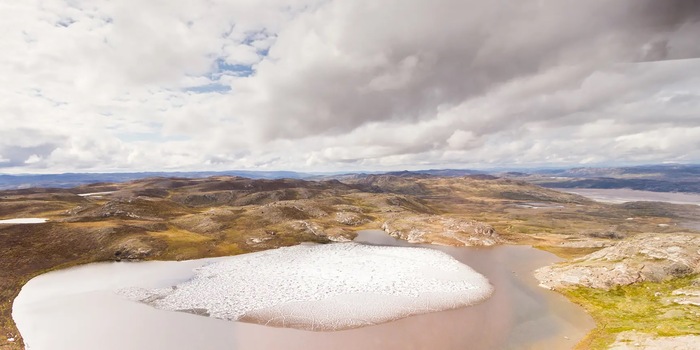
When Greenland really was a green country
A long-forgotten drill core from the north-west of Greenland shows that the island was ice-free in the recent geological past. With consequences for global sea levels.
A little more than 400,000 years ago - a geological blink of an eye - large parts of north-west Greenland were probably ice-free. The landscape was characterised by tundra and perhaps even trees. This is suggested by the analysis of an ice core taken during the Cold War at the secret US Camp Century and reported on by Paul Bierman from the University of Vermont and his team in "Science". During the warm period at that time, temperatures were at a level that is expected for the end of the 21st century.
Scientists had long assumed that Greenland was largely glaciated during the last 2.5 million years. However, an initial examination of the drill core, which had been forgotten, indicates that there must have been a phase without ice in the last million years: The remains of tundra plants were found in drilled sediments. However, the exact time remains unclear.
Bierman and Co. therefore re-examined the drill core from Camp Century using luminescence technology: the presence or absence of light influences existing sediments, which can be detected using this technology. This allows conclusions to be drawn as to when certain layers were still exposed to the sun. The researchers were then able to compare the data using the isotope ratio of beryllium and aluminium in quartz crystals: It also shows how long the material was openly exposed to cosmic radiation.
In this way, the team was able to calculate that the area was ice-free 416,000 years ago. In total, the ice-free phase lasted around 16,000 years. The ice loss can therefore be attributed to a warm phase called Marine Isotope Stage 11 (MIS 11), which was only slightly warmer than today with lower carbon dioxide levels in the atmosphere in this region. The melting contributed at least 1.6 metres to the rise in sea levels at that time, Bierman and co. write.
This suggests that the Greenland ice sheet may be more sensitive to human-induced climate change than previously thought, the team writes. The continuing rise in temperatures is therefore likely to trigger irreversible, rapid melting of the ice sheet in the coming centuries, even if we stop our carbon dioxide emissions immediately. "If we melt only parts of the Greenland ice sheet, sea levels will rise dramatically," says Tammy Rittenou from Utah State University in Logan, who was involved in the study. "If we continue to model the melt rates and the response to high carbon dioxide, we see sea levels rising by several metres, probably even tens of metres."
The story behind the drill core is also interesting: Camp Century was a military base hidden in tunnels under the Greenland ice in the 1960s. The strategic purposes of the camp included a top-secret operation called "Project Iceworm", in which hundreds of nuclear missiles were to be hidden under the ice near the Soviet Union. As a cover, the army claimed that the camp was an Arctic research station. The missile mission was a failure, but the science team carried out research in the region for the first time - including drilling an ice core almost a kilometre deep. The scientists at Camp Century focussed on the ice itself in order to better understand the Earth's past ice ages and warm periods. However, they were the only team to date to drill several metres deep into the sediment under the glacier, which they were not interested in at the time and which was only investigated in more detail from 2018 onwards.
In the 1970s, the ice core was then taken from a military freezer to the University of Buffalo and finally to Denmark in the 1990s, where it was forgotten. It was only when it was to be placed in a new freezer together with other drill cores that it was remembered again.
Spectrum of Science
We are partners of Spektrum der Wissenschaft and want to make well-founded information more accessible to you. Follow Spektrum der Wissenschaft if you like the articles.
[[small:]]
Cover image: © Joshua Brown (detail) Some ice is still melting in a pond on Greenland. It could have looked similar 400,000 years ago - on a much larger scale.
Experts from science and research report on the latest findings in their fields – competent, authentic and comprehensible.